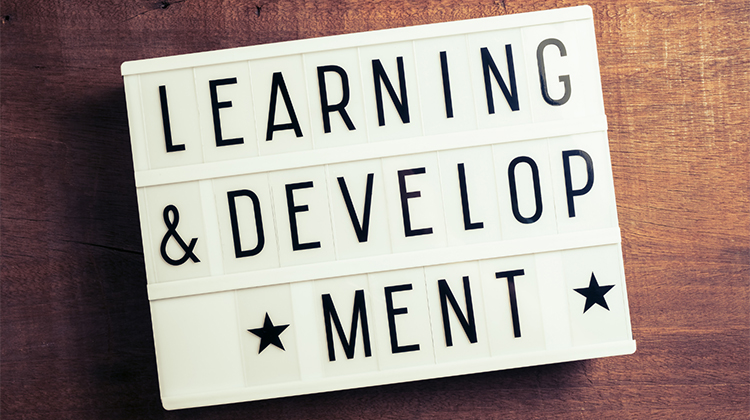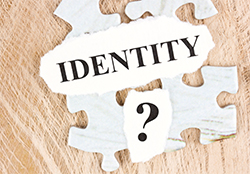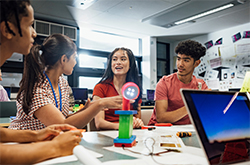Wellbeing Across the Educational Landscape - Article 4: Wellbeing Considerations to Support Adolescent Students' Learning

In Article #4 of the "Wellbeing Across the Educational Landscape" series, we look at developmental and wellbeing factors affecting adolescent students. This includes an application of Erikson's theory of psychosocial development, brain development and functioning, leveraging multisensory learning, explorative learning experiences, and educational processes which intentionally and unintentionally influence student identity formation. Practical strategies are then presented to support adolescent students' wellbeing and learning.
Erikson's Theory of Psychosocial Development Continuing on from the childhood psychosocial challenges outlined in Article #3 of this series, adolescents face their own challenge;
Continuing on from the childhood psychosocial challenges outlined in Article #3 of this series, adolescents face their own challenge;
● Stage 5 - Identity vs confusion (12-18 years). As adolescents develop their sense of self, they examine their values, beliefs and goals. Existential questions may include; Who am I? Where do I belong? What will I do with my life? Encouraging self-directed investigation of different ideas and roles will support adolescents to successfully navigate this stage, and develop a strong sense of identity. Lack of self-directed exploration, or externally-imposed pressure to conform to conflicting values or beliefs, will lead to confusion.
Brain Development and Functioning Neuroscience shows that extensive changes in brain development and functioning occur during adolescence. During early adolescence development of the limbic system (associated with rewards, punishments, emotions, social information, and dopamine levels) can lead to greater responsiveness to boredom, rewards and stress, and increased risk-taking. Meanwhile the prefrontal cortex (involved in impulse control, self-regulation, planning and reasoning) undergoes significant synaptic pruning, and does not develop until later adolescence. Nonetheless, adolescent brains are wired to learn and adapt, and are shaped by experience. Therefore, classroom practices supporting multisensory learning are essential.
Neuroscience shows that extensive changes in brain development and functioning occur during adolescence. During early adolescence development of the limbic system (associated with rewards, punishments, emotions, social information, and dopamine levels) can lead to greater responsiveness to boredom, rewards and stress, and increased risk-taking. Meanwhile the prefrontal cortex (involved in impulse control, self-regulation, planning and reasoning) undergoes significant synaptic pruning, and does not develop until later adolescence. Nonetheless, adolescent brains are wired to learn and adapt, and are shaped by experience. Therefore, classroom practices supporting multisensory learning are essential.
Multisensory Learning in the Classroom Multisensory learning opportunities support brain integration and strengthen neural networks, and improve learning and information integration. Furthermore, multisensory learning supports foundational skill development including safety, regulation, exploration, movement,
Multisensory learning opportunities support brain integration and strengthen neural networks, and improve learning and information integration. Furthermore, multisensory learning supports foundational skill development including safety, regulation, exploration, movement,
attention, reading, writing, organisation, and social engagement.
Extending beyond the 5 well-known sensory systems, multisensory learning can incorporate 8 sensory systems;
1 Auditory - what we hear. Involved in spatial awareness, attention, social engagement, safety, and balance.
2 Visual - what we see. Involved in safety, environmental awareness, social engagement, hand-eye coordination, balance, and depth perception.
3 Tactile - what we touch. Involved in self-regulation and emotional security, holding and manipulating objects, and body awareness.
4 Gustatory - what we taste. Involved in safety, and meeting basic needs of hunger and thirst.
5 Olfactory - what we smell. Involved in safety, and emotions related to our memories.
6 Proprioceptive - our perception of our body in relation to our physical environment. Involved in self-regulation, using force, holding and manipulating objects, and navigating the physical environment.
7 Vestibular - our perception of our relationship to gravity and orientation in space. Involved in balance, motor coordination, muscle tone, maintaining alertness and attention, and visual orientation.
8 Interoceptive - our perception of our internal bodily functions and needs (eg. hunger, heart rate, safety). Involved in emotional awareness, bodily needs, and safety.
All 8 sensory systems have two subtypes called sensory modulation and sensory discrimination, in addition to a 9th subtype of sensory integration called sensory-based motor skills.
 Sensory Modulation involves selective attention to increase or limit the amount of sensory input received, to prevent getting over-stimulated, under-stimulated, or falling over. Sensory modulation is involved with our sense of safety. Sensory modulation varies from student to student and situation to situation, and so affects student behaviour depending on the day, time or class.
Sensory Modulation involves selective attention to increase or limit the amount of sensory input received, to prevent getting over-stimulated, under-stimulated, or falling over. Sensory modulation is involved with our sense of safety. Sensory modulation varies from student to student and situation to situation, and so affects student behaviour depending on the day, time or class.
Stress, poor sleep and diet can impact sensory modulation because our nervous systems will be more stressed and overwhelmed. This can lead to agitation and over-stimulation, and the student may need to reduce their sensory input to regain regulation and functioning. Conversely, a student may 'switch off' and become
under-stimulated, and they will require more sensory input to regain regulation and functioning.
Sensory Discrimination is being able to determine, and use, different time and space properties of sensory input as we live our lives. This is what we do with the input rather than how we react to the input. For example, we might see a vicious dog running towards us (sensory modulation) and we can tell where and how fast the dog is moving (sensory discrimination). It can help us distinguish, and respond to, familiar versus unfamiliar sensory input by anticipating properties of sensory inputs. For example, students use discrimination when writing or typing on a computer, or listening to sounds and voices outside at lunchtime.
Repeated exposure to a wide variety of sensory input will support sensory discrimination, which will in turn increase precision with tasks. Sensory discrimination requires more focussed attention than sensory modulation. Engaging a variety of sensory systems in a single task can support students with sensory discrimination differences.
Sensory-based Motor Skills support praxis (such as sequencing and motor execution) and postural stability. Sensory-based motor skills involve tactile, vestibular, and proprioceptive information for motor output, such as planning and movement. Sensory-based motor skills are the basis for strong executive function skills - managing our bodies before managing other areas of life.
Dyspraxia is a form of difficulty with sensory-based motor skills, which can be supported with;
● Time and patience, especially when introducing new activities
● Backward chaining and scaffolding
● Co-regulation to decrease anxiety
In support of Erikson's theory, studies found that psychosocial need fulfilment of autonomy, competence and relatedness can lead to high school students' improved agency, responsibility, academic achievement, and career decision-making self-efficacy. Interpersonal justice was also found to positively predict student responsibility when evaluations, rewards, punishments, and interpersonal relations were perceived as fair and deserved. Schools and teachers may unintentionally influence adolescents’ identity development through a "hidden curriculum", where educational processes implicitly communicate who students are, should or could be. Conversely, intentionally designing explorative learning experiences can positively support students' identity development
Strategies to support adolescents' psychosocial and brain development;
● Encourage peer interactions, which support emotional development and social status linked with identity development
● Provide just and deserved evaluations, rewards, punishments and interpersonal treatment
● Provide opportunities for students to influence their own learning environment and processes
● Intentionally design explorative learning experiences which are meaningful, delivered in a supportive class climate, and support adolescents to:
○ explore new identity positions (in-breadth exploration),
○ further develop existing self-understandings (in-depth exploration), and
○ reflect on self-understandings (reflective exploration).
● Identify and eliminate educational processes which unintentionally influence student identity formation including;
○ selection practices at the school level or differentiation processes at the classroom level,
○ teaching strategies which inform opportunities to engage in the classroom and learning content with students limited by tools, norms, and values
○ how teaching strategies make certain identity positions available in the classroom
○ teacher expectations, and
○ peer norms.
Strategies to leverage multisensory learning in the classroom;
● Include diverse sensory inputs and sensory subtypes
○ incorporate a few of the different sensory systems into classroom instruction and activities eg. connecting students with a ball of string to connect/map learning concepts
○ consider how students' sensory modulation, sensory discrimination, or sensory-based motor skills.
● Support sensory preferences when possible.
○ help students identify their sensory preferences
○ split into smaller groups or learning areas which provide more or less of specific sensory inputs ie. sound, light, colours, textures, movement etc.
● Use learning materials or methods that are novel but subtle, to maintain attention and support regulation. This can include;
○ changing the tone of your voice
○ getting to students to white on the whiteboard
○ moving around the room
○ find the balance between catching attention, and being too distracting!
● Engineer the learning environment with sensory inputs that tend to be calming and supportive for most people (as opposed to sensory inputs which are tailored to individual preferences). This can effectively engage more, or less, sensory systems during learning.
○ dimmer lights to calm and relax vs. brighter lights to increase alertness
○ soothing music to relax vs. quiet or distinct sounds to improve concentration
○ sitting or lying down to calm vs. movement to engage
○ different essential oils for calming or alertness
○ match sensory inputs to student arousal levels, time of day, or activity type
○ start with 1-2 multisensory activities per day, and work towards using 1-2 multisensory activities during each class
○ if individual students get over-aroused or under-aroused by certain sensory inputs, co-regulate to help students regain regulation (see Article #1 of this series for a more detailed discussion of co-regulation). Then adapt the sensory input to the students' needs.
Many of the supports and considerations relevant to young students also apply to adolescent students. Please see Article 3 for a more detailed discussion of;
● The impact of developmental trauma
● The Department of Education and Training's 'High Impact Wellbeing Strategies Resource'
● Positive education principles
● Advocating for students' voices and choices
● Cost-effective enhancement of classroom climate, and
● Developing community-mindset.
In closing, some considerations;
● What are some strategies that you already have in place to support adolescent students' wellbeing and learning?
● Select 2 new strategies to implement over the coming weeks.
Stay tuned for Article #5 in this series, providing strategies to support adult students' development, wellbeing and learning.
With best wishes,
Kim
(The information in this article is not intended as medical advice. For persistent stress or specific support, professional healthcare is advised.)
Kim Vanderwiel (BA-BEHP(Psych), GDipCouns, AdvCert Guiding & Teaching Meditation & Mindfulness (In Progress)) has a background in clinical research, counselling, mindfulness and meditation, and is the founder and CEO of the Practical Wellbeing Institute. Kim has supported the wellbeing of young people and adults with different identities, needs and experiences, including; mental health challenges, trauma, neurodiversity, learning difficulties, LGBTQIA+, and multiculturalism. Kim is particularly passionate about supporting post-traumatic growth, and helping people thrive.